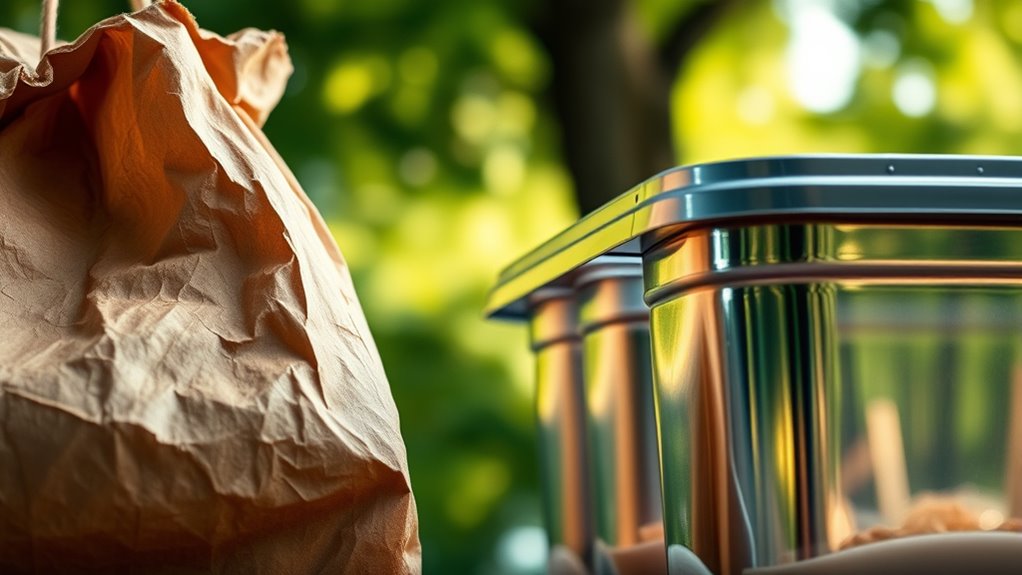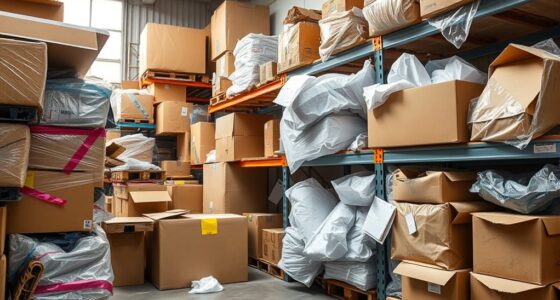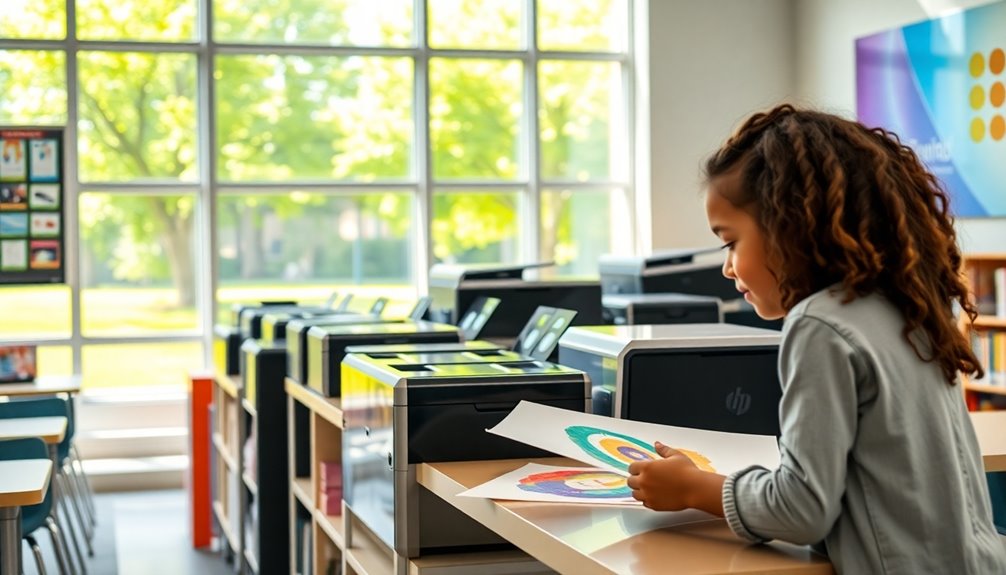Choosing between paper and plastic packaging impacts the environment differently. Paper is biodegradable and easier to recycle, but its production uses lots of water and energy, and it decomposes faster in nature. Plastic lasts longer, resists degradation, and can often be reused, but it pollutes oceans and ecosystems for centuries. Understanding these differences helps you make more sustainable choices—continue exploring how each material truly affects our planet.
Key Takeaways
- Paper is biodegradable and decomposes faster, reducing long-term environmental harm, unlike plastic which persists for hundreds of years.
- Recycling paper is easier and more environmentally friendly than plastic, which requires specialized processes and remains in ecosystems longer.
- Plastic production relies on non-renewable fossil fuels, contributing significantly to carbon emissions, whereas paper’s environmental impact depends on sustainable forestry.
- Plastic waste causes severe pollution, especially in oceans, with microplastics harming wildlife; paper waste biodegrades more quickly with less ecosystem damage.
- Innovations like biodegradable plastics and sustainable packaging aim to improve environmental impacts, but current plastic pollution remains a major environmental challenge.
Material Composition and Recycling Potential

When comparing paper and plastic packaging, understanding their material composition is essential because it directly affects how easily they can be recycled. Paper is made from cellulose fibers, which are naturally biodegradable and tend to break down faster in the environment. This enhances its recycling efficiency, making it easier to process and reuse. Additionally, paper packaging can often be composted as it decomposes naturally and enriches the soil. Plastic, on the other hand, is derived from polymers like polyethylene or polypropylene, which are not biodegradable and require specific recycling methods. This often lowers its material biodegradability, leading to longer persistence in landfills and the environment. The differences in composition determine how effectively each material can be recycled and how quickly it degrades naturally. Recognizing these distinctions helps you better understand the environmental impacts of choosing paper or plastic packaging. Additionally, the recyclability of each material can vary depending on local recycling facilities and regulations, influencing their overall environmental footprint.
Resource Consumption During Production

When comparing paper and plastic packaging, you’ll notice that producing each consumes different amounts of raw materials, energy, and water. Paper manufacturing requires significant water and energy for pulp processing, while plastic production relies heavily on fossil fuels during extraction and refining. Understanding these resource demands helps you see the true environmental costs behind each packaging type. Additionally, the resource consumption in paper production can vary depending on the pulp processing technology used, which impacts overall environmental impact. The choice of sustainable resource management practices can further influence the ecological footprint of paper packaging. Moreover, advancements in energy-efficient processes are helping reduce the environmental impact of paper manufacturing. Incorporating renewable energy sources into production facilities is also a growing trend to minimize reliance on fossil fuels and decrease emissions. Implementing green manufacturing methods can also contribute significantly to lowering the overall environmental footprint of paper packaging.
Raw Material Extraction
The extraction of raw materials for both paper and plastic packaging consumes significant natural resources, impacting ecosystems and depleting finite reserves. Forest harvesting is a key part of raw material sourcing for paper, requiring large areas of trees to be cut down, which can lead to deforestation and habitat loss. In contrast, plastics are derived from petroleum, a non-renewable resource extracted through drilling and mining. Both processes demand substantial energy and water, placing further strain on environmental systems. As you consider the raw material sourcing, recognize that paper relies heavily on sustainable forestry practices to reduce ecological damage. Plastic, however, depends on fossil fuels, contributing to resource exhaustion and pollution. Additionally, the extraction processes for both materials involve significant energy consumption, further impacting environmental sustainability. The environmental impact of these extraction methods is compounded by the carbon footprint associated with processing and transportation. Overall, both extraction methods have notable ecological footprints, emphasizing the importance of sustainable practices in resource management.
Manufacturing Energy Use
Both paper and plastic packaging manufacturing demand significant energy, which directly affects their overall environmental impact. The energy required varies depending on material sourcing; paper production often involves intensive energy use during pulping and drying, while plastics rely on energy-heavy polymerization processes. Your recycling infrastructure plays a vital role—efficient systems reduce the need for new material sourcing, lowering energy consumption. Recycling paper uses less energy compared to virgin production, but the process still consumes considerable power. Energy-intensive processes in plastic manufacturing, particularly from virgin sources, demands large energy inputs, increasing its carbon footprint. By improving recycling infrastructure and optimizing material sourcing, you can cut down energy use in both manufacturing stages, ultimately minimizing environmental impacts and promoting more sustainable packaging choices. Additionally, adopting creative problem-solving techniques can help identify innovative ways to reduce energy consumption throughout the manufacturing process.
Water Requirements
Understanding the water requirements for packaging materials reveals significant differences in resource consumption during production. Paper packaging typically demands high water consumption, especially during pulping and papermaking, leading to a notable hydration impact on local water sources. This process can strain water supplies and affect ecosystems. In contrast, plastic production, primarily based on petrochemicals, uses relatively little water during manufacturing, but its overall water footprint is impacted by extraction and refining. While plastics require less water directly, their production still contributes to water pollution and resource depletion. Additionally, the integration of neural network technology in manufacturing processes can optimize water use efficiency, reducing environmental impacts. By examining water requirements, you see that paper’s hydration impact is more immediate and intense, whereas plastic’s water footprint is more indirect but still significant. This comparison highlights the importance of considering water use in environmental impact assessments.
Carbon Footprint and Greenhouse Gas Emissions

When comparing paper and plastic packaging, it’s essential to take into account their carbon footprints and greenhouse gas emissions, as these factors considerably influence the environment. Plastic production generally emits fewer greenhouse gases than paper, but plastic’s reliance on fossil fuels increases its overall carbon footprint. Plastic’s dependence on fossil fuels significantly contributes to its environmental impact and warrants consideration. Additionally, the development of robust safety measures in manufacturing can help mitigate unintended environmental consequences. Paper, on the other hand, involves energy-intensive manufacturing and deforestation, which add to its emissions. Recycling infrastructure plays a critical role in reducing these impacts; efficient recycling reduces the need for new resource extraction, lowering emissions. Furthermore, carbon offsetting strategies can help mitigate the environmental effects of both materials, especially when recycling options are limited. The fiber content of paper can also influence its environmental impact, as high-quality recycled paper can further reduce waste and emissions. Moreover, understanding the full lifecycle of packaging materials is crucial for making sustainable choices and minimizing environmental harm. Recognizing the environmental impact of production can guide better decision-making and promote sustainable practices. Ultimately, understanding the full lifecycle and improving recycling infrastructure are key to minimizing the greenhouse gases associated with packaging choices.
Biodegradability and Decomposition Rates

Biodegradability and decomposition rates critically influence the environmental impact of packaging materials. You’ll find that paper generally biodegrades faster than plastic, thanks to its natural fibers. This biodegradation speed means paper can break down within a few months under proper conditions. Biodegradation process is facilitated by microbes that can efficiently break down cellulose, which contributes to the rapid decomposition of paper. Plastic, on the other hand, often takes hundreds of years to fully decompose, if at all, due to its resistant polymers. The decomposition process for paper involves microbes breaking down cellulose, which happens relatively quickly. In contrast, plastics resist microbial activity, leading to persistent waste in landfills and ecosystems. Your choice of packaging material impacts how quickly waste can return to the environment, reducing long-term pollution. Faster biodegradation minimizes environmental harm, making paper a more eco-friendly option in terms of decomposition rates. Additionally, advances in AI in Education are exploring ways to optimize recycling and waste management processes, further supporting environmentally sustainable practices.
Pollution and Waste Management Challenges

Pollution from packaging waste poses significant challenges for waste management systems worldwide. Single-use concerns are at the core, as most plastic and paper packaging is discarded after a single use, quickly piling up in landfills and oceans. This creates a burden for waste reduction efforts, which struggle to keep pace with increasing consumption. Plastic packaging, in particular, persists for hundreds of years, contaminating ecosystems and harming wildlife. Paper packaging, while biodegradable, still contributes to waste if not properly recycled. Managing this waste requires robust collection, sorting, and recycling systems, but many areas lack proper infrastructure. The recycling processes are often inefficient or underfunded, further complicating waste management efforts. Developing sustainable packaging solutions is essential to mitigate these environmental impacts and promote more effective waste management practices. The result is overflowing landfills, environmental pollution, and increased pressure on waste management resources, highlighting the urgent need for sustainable packaging solutions that address these challenges effectively.
Energy Use in Manufacturing Processes

The manufacturing processes behind paper and plastic packaging consume substantial amounts of energy, directly impacting their overall environmental footprint. Paper production involves cutting trees, pulping, and drying, which require significant energy inputs. Conversely, plastic packaging manufacturing relies on fossil fuels, with energy-intensive polymerization and molding steps. These processes influence the biodegradation timeline, as energy consumption during production affects the material’s composition and environmental breakdown. Plastic often takes hundreds of years to biodegrade, partly due to its manufacturing method, while paper decomposes much faster. Improving energy efficiency in production can reduce emissions and resource use, making both options more sustainable. By understanding these energy demands, you can better evaluate the true environmental costs of each packaging type.
Impact on Wildlife and Marine Environments

While both paper and plastic packaging can harm wildlife and marine environments, plastics pose a more immediate and persistent threat. Plastic waste often ends up as marine debris, floating in oceans and rivers, where it harms marine life. Animals may ingest plastic or become entangled, disrupting their natural behaviors and damaging their habitats. Plastic debris can break down into microplastics, contaminating the water and entering the food chain. In contrast, paper packaging decomposes more quickly, posing less long-term risk to wildlife habitats. However, improper disposal of either material contributes to environmental degradation. Your choices impact the health of ecosystems; reducing plastic use helps protect marine environments and preserves wildlife habitats from the damaging effects of persistent debris.
Reusability and Lifecycle Durability

When considering reusability, you’ll notice that plastic packaging often withstands multiple uses better than paper. Lifecycle longevity depends on how well each material holds up over time and how easily it can be recycled afterward. Understanding these durability factors helps you choose packaging that lasts longer and reduces waste.
Durability and Reusability Factors
Durability and reusability are key factors that determine how well paper and plastic packaging hold up over time. During durability testing, you’ll see how each material withstands various stresses, such as handling, moisture, and weight. Plastic packaging generally scores higher because it’s more resistant to tearing and damage, making it suitable for multiple uses. Paper, being more fragile, often requires careful handling to prevent tearing or breaking. Reuse strategies can extend the life of plastic packaging through cleaning and proper storage, while paper packages might be reused for lightweight tasks or as compostable options. Your choice depends on how durable you need the packaging to be and whether reusability aligns with your sustainability goals. Ultimately, plastic’s durability often makes it more suitable for repeated use.
Lifecycle Longevity and Recycling
Plastic packaging often outlasts paper in its lifecycle, thanks to its resistance to wear and tear over extended use. This durability means plastic can be reused multiple times, but it also impacts biodegradation rates, as many plastics take hundreds of years to break down. Recycling infrastructure plays a vital role in managing plastic waste, but it’s not always widely available or efficient. Paper, on the other hand, generally biodegrades faster, reducing long-term environmental impact. However, paper’s recyclability depends on the quality and contamination levels, which can hinder processing. Overall, plastic’s longer lifecycle offers reusability benefits, yet its slower biodegradation contrasts with paper’s quicker breakdown, highlighting the importance of robust recycling infrastructure for sustainable waste management.
End-of-Life Disposal and Recycling Rates

End-of-life disposal and recycling rates considerably influence the environmental impact of paper and plastic packaging. Paper packaging typically has a higher recycling efficiency, meaning more of it can be processed into new products, reducing waste. Its biodegradation rate is quicker, allowing it to break down naturally within months, lessening landfill accumulation. Plastic, however, often faces lower recycling rates due to contamination and sorting challenges, leading to more waste ending up in landfills or oceans. Its biodegradation rate is markedly slower, sometimes taking hundreds of years to decompose. Proper disposal methods are vital; recycling reduces resource use and pollution, but only if materials are properly sorted and processed. Your choices and disposal habits directly affect how effectively these materials are recycled or biodegraded.
Overall Sustainability and Future Outlook

Looking ahead, you’ll see that sustainability challenges remain as both options endeavor to reduce environmental impact. Innovations like biodegradable materials and improved recycling methods offer promising solutions for a greener future. Staying informed about these developments helps you understand how packaging choices can shape a more sustainable world.
Sustainability Challenges Ahead
Although both paper and plastic packaging face significant sustainability challenges, the road ahead requires innovative solutions to reduce environmental impacts. Improving recycling infrastructure is essential, as it determines how effectively materials are reused and diverted from landfills. Without better systems, even recyclable packaging loses value, increasing waste. Additionally, consumer awareness plays a crucial role; if people understand the environmental consequences and adopt responsible habits, the demand for sustainable options will grow. Education campaigns and clear labeling can guide consumers toward better choices. However, overcoming existing infrastructure limitations and shifting behaviors remain complex tasks. Addressing these challenges demands coordinated efforts among manufacturers, policymakers, and consumers to create a more sustainable packaging future.
Innovations for Eco-Future
Innovations in packaging technology are paving the way for a more sustainable future by developing materials that are both eco-friendly and cost-effective. You’ll see more alternative packaging options, like biodegradable plastics and plant-based materials, gaining prominence. These innovations directly influence consumer behavior, encouraging eco-conscious choices and reducing reliance on traditional plastic. As awareness grows, consumers become more willing to embrace sustainable packaging solutions, pushing companies to innovate further. Advanced recycling techniques and edible packaging are also emerging, minimizing waste and environmental impact. Your role as a consumer can drive these changes by supporting brands that prioritize sustainable alternatives. Overall, these innovations point toward a future where packaging reduces environmental harm while meeting economic needs, fostering a more sustainable, eco-friendly landscape.
Frequently Asked Questions
How Do Consumer Behaviors Influence the Environmental Impact of Packaging Choices?
Your consumer habits and recycling practices directly shape the environmental impact of packaging choices. When you opt for eco-friendly options and commit to recycling, you reduce waste and conserve resources. Your behavior encourages companies to prioritize sustainable materials and responsible production. By making conscious choices and promoting recycling, you help minimize pollution and support a healthier planet, emphasizing how your actions can drive positive change in packaging sustainability.
Are There Innovative Materials That Outperform Paper and Plastic Environmentally?
You might be surprised to learn that innovative materials like biodegradable alternatives are outperforming traditional paper and plastic in environmental impact. These materials, made from plant-based sources or algae, break down more quickly and reduce pollution. By choosing products with these eco-friendly options, you help lower waste and support sustainable practices, making a real difference for the environment. Keep an eye out for new, innovative materials that prioritize sustainability.
What Policies Are Most Effective in Promoting Sustainable Packaging?
You can promote sustainable packaging by supporting policies like recycling incentives that encourage consumers to recycle more and eco labeling standards that help identify environmentally friendly products. These policies motivate companies to adopt greener practices and educate consumers on sustainable choices. By advocating for stronger recycling programs and clear eco labels, you help reduce waste and environmental impact, steering industries toward more responsible packaging solutions.
How Does Packaging Waste Affect Local Communities and Economies?
You might not realize it, but packaging waste impacts your community and economy considerably. Improper disposal can clog local recycling programs, making waste management more challenging. This increases economic costs for municipalities and taxpayers. Additionally, litter can harm local environments, affecting tourism and businesses. Supporting better waste reduction and recycling efforts helps reduce these impacts, ensuring your community stays clean, healthy, and economically vibrant.
Can Biodegradable Plastics Truly Replace Traditional Plastics Sustainably?
You might wonder if biodegradable plastics can truly replace traditional plastics sustainably. While they’re designed as sustainable alternatives, they often require specific conditions to break down and may still impact the environment if not properly managed. Biodegradable plastics offer promise, but you should consider their lifecycle and potential environmental footprint. To guarantee sustainability, you need to support proper composting systems and continued innovation in biodegradable plastics technology.
Conclusion
Choosing between paper and plastic packaging is like picking between a sturdy tree and a fleeting shadow—you want something that lasts. Remember, paper decomposes faster and can be recycled more easily, but it still consumes resources. Plastic, while durable, pollutes oceans and harms wildlife. Your choices matter; by considering their environmental impacts, you help guarantee a healthier planet—because, like a small drop creating ripples, your decision can make a big difference.










